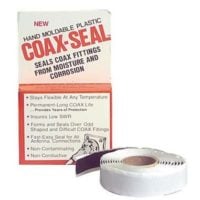This subject comes up once in a while so I thought I’d take the time to describe how I splice wires and make connections with my trailer wiring.
1) Get the wire clean. Just like so many other things we do, surface preparation is important. Shiny like a new penny. Scrape it with a knife, use sand paper, what ever. But get the corrosion layer off the wire.
2) It all starts with a good MECHANICAL connection. I use what is called a “Western Union Splice”. This is a way of wrapping two wires together that ends up stronger than the wire in the first place. Very hard to pull this apart. See the picture below.
3) Solder the wires together. Any purely mechanical method…butt splices, etc…..will fail eventually. Solder should last for years and years. Don’t use acid flux solder, the acid never stops working and will eventually eat up the wire. Use Rosin flux.
4) Cover the soldered connection with Coax Seal (see picture below). This stuff is a putty, easy to work with, and it stay pliable for decades. And it’s totally water proof. Solder that’s exposed to the weather will corrode just like any other metal and needs to be protected. The stuff is cheap and you can find it at a lot of places, including Amazon and Ebay.
5) Cover everything with good electrical tape. Buy the “good stuff”, like 3M. And one hint here, cut the tape off and push it down around the joint. Don’t pull on the roll until the tape breaks off. That leaves a lot of stress in the tape and it will pull loose eventually.
This might seem like a lot of screwing around, but understand that I have built antennas this way that have been up for decades without a problem. I’ve taken apart connections that were many years old and the solder was still clean and shiny. I’ve never had a splice made this way on a trailer wire fail.
S.R.



